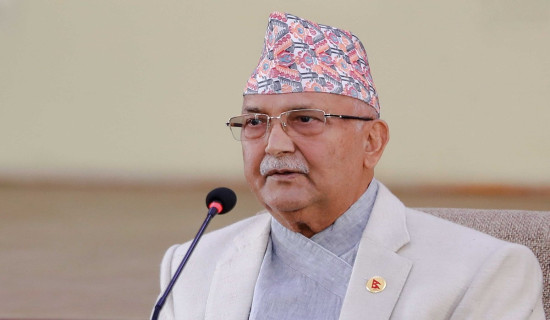- Monday, 5 January 2026
Security Alliances Threaten Peace
Certain events mark a turning point in the history of humanity. The dropping of atom bomb in Japan in 1945 changed the course of the World War II. It ended the European era in the international power architecture giving rise to bipolar world wherein United States and Soviet Union emerged as superpowers. In the World War II, Japan and Germany were badly defeated whereas war severely weakened British might. Only two countries emerged victorious in the war —the United States and Soviet Union.
Washington and Moscow drew the map of the post- World War II world. They divided Europe into their spheres of influence. The world, too, appeared divided into two camps. The divide was given ideological colour as capitalist democracy versus communism. The rivalry was more for the quest of hegemony rather than the ideological basis. Both the camps tried to consolidate their sphere of influence for which they built security alliances of different kinds. The North Atlantic Treaty Organisation (NATO) was created as US-led security alliance of which 32 Atlantic and European countries are members.
Security alliances
Finland and Sweden are the newest members. US also built several other security alliances in other parts of the world. The Central Treaty Organisation was formed in 1955 with Turkey, Iraq, UK, Pakistan and Iran as members. US, France, Britain, New Zealand, Australia, the Philippines, Thailand and Pakistan formed the Southeast Asia Treaty Organisation, (SEATO) in 1954. A three-nation security alliance called ANZUS (Australia, New Zealand and United States) came into being in 1951. In response to these security initiatives and alliances, Soviet Union created the Warsaw Pact with some East European communist countries as members. Now these security alliances cease to exist except NATO.
A cluster of countries created the non-aligned group refusing to be part of any of the two power blocs. In practical sense, many countries in non-aligned movement were, one way or another, aligned with either of the two camps. The non-aligned movement didn’t have any role in global power equation. The crack appeared in the Soviet bloc following Sino-USSR split in 1960s especially after Khrushchev’s rise in power in Kremlin. Russia-China conflict was partly ideological and partly strategic as Moscow refused to cooperate with China’s nuclear programme.
Washington hastened to reap benefit out of the simmering row between Moscow and Beijing. The historic 1972 Nixon-Mao meeting served as a turning point in altering post-World War II international balance of power. Although China did not join the US-led security alliance, the US-China closeness marked the new era in history of international power politics. The fall of Berlin Wall was yet another historic event that led to the formal disintegration of the Soviet Union, thus, heralding the rise of US-led unipolar world formally ending the Cold War and changing the course and contours of world politics.
While Vietnam War in 1960s and 70s partially contributed to the decline of US might paving the way for the rise of Soviet Union as a super power, invasion in Afghanistan caused dearly to the Soviet Union that ultimately led to the fall of Soviet empire like the house of cards. Similarly, US war in Afghanistan under the façade of war on terror led to the fading of US might that gave rise to China as a great power in the international landscape. Now the international architecture of power has changed and the principal rivalry is between the United States and China. United States labels China as acute and main threat while Russia as temporary threat in European theatre.
However, China rejects the US allegation and says its rise is for peaceful purpose and does not pose threat to any country. Since US has designated China as the principal threat, the new theatre of geopolitical rivalry has shifted to Asia.
The United States has come up with newer strategic construct and is building different security alliances in Asia for the purpose of containing China’s rise. The quadruple alliance or Quad of US, Japan, India and Australia and trilateral security partnership or AUKUS (Australia, UK and US) are the newest example security alliance in the Indo-Pacific region. These security alliances in the Indo-Pacific region remind the alliance politics of the Cold War era.
China’s Belt and Road Initiative (BRI) and its other integral instruments like Global Security Initiative (GSI), Global Development Initiatives (GDI), and Global Civilizational Initiative (GCI) have been interpreted by the West as Beijing’s strategic arm to enlarge influence across the world. Similarly, the BRICS and Shanghai Cooperation Organisation (SCO) are also being interpreted as China’s other tools to alter the West-led international order.
NATO expansion
NATO is expanding eastward in Europe purportedly to check Russia while several other US-led alliances are at work in Indo-Pacific region to contain China. Western concerns and alarms in Europe are understandable in Europe after Russia’s invasion in Ukraine. But hyper military activism and growing security and military alliances in the Indo-Pacific region are matters of serious concern for all in this region. The military and alliance race in Indo-Pacific region may lead to further military conflict destabilising peace in Asia.
Amidst this fear and scepticism, Russian President Vladimir Putin and Chinese President Xi Jinping met in Beijing recently and vowed to deepen their strategic partnership seeking to deter US hegemony and create a new world order. While Russia has a history of repeated military invasions in other countries, China has been a pacifist power.
Thus, the fundamental behaviour of these two countries is different. However, China and Russia have common objective that is to deter West’s hyper politicking and strategic advancements in Europe and Indo-Pacific region. China-Russia romance may turn the table in the international balance of power as it did in the past. But it remains to be seen whether this is mere marriage of convenience or genuinely motivated for a just world order.
(The author is former ambassador and former chief editor of this daily. lamsalyubanath@gmail.com)
















